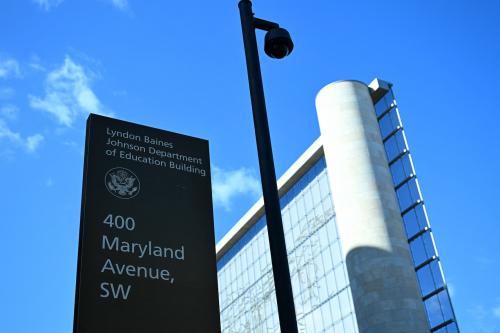

1:30 pm EST - 2:30 pm EST
Past Event
On December 16, 2022, the Brown Center on Education Policy at Brookings hosted a virtual event to examine equity in school finance. The event featured findings from a new Brown Center report on funding inequities and the factors that shape them, as well as a panel discussion on how to use resources to improve student outcomes amid the negative effects of COVID-19 and the impending expiration of federal stimulus funds.
Sarah Reber, senior fellow in Brookings’ Economic Studies Program, briefly introduced the topic and moderated the panel discussion.
Michael Hansen, senior fellow in Brookings’ Brown Center on Education Policy and one of the report’s co-authors, provided a summary of its findings. First, district-to-school allocations are slightly progressive on average (i.e., schools that serve more students in poverty get slightly higher per-pupil funding than other schools in the same district), but not all districts are progressive, and the ones that are might not be progressive enough to address today’s opportunity gaps. Second, schools that serve more students in poverty tend to have more staff per pupil but less experienced teachers than other schools in the same district. The study uses newly available school-level data to report on allocations of school finances within school districts, a level of analysis that was previously only possible at small scales.
Marguerite Roza, Research Professor and Director of the Edunomics Lab at Georgetown University, then described how education finance research is shifting from a focus on state-level funding formulas to one that questions how resources are distributed across schools. Roza’s Edunomics Lab has been facilitating this changing focus in research through the newly established National Education Resource Database on Schools (NERD$), a data warehouse for newly available school-level data. The Edunomics Lab has worked to standardize those data and make them available for researchers. Roza believes that we are, for the first time ever, acquiring the ability to look “under the hood” at districts’ resource allocations. She sees a lot of variation across districts.
Richard Bowman, Chief Information and Strategy Officer at Albuquerque Public Schools, offered an up-close perspective on district spending patterns. These spending decisions, Bowman argues, are dictated by pressures from diverse student needs and competing sets of stakeholders in the district. Consequently, resource allocations often are not intentionally chosen for strategic purposes and are difficult to change in order to align with student needs, even if such an allocation is desirable for equity.
The panel discussed the interplay of teacher and financial resource allocations, one of the issues analyzed in the new Brown Center report. Roza posed a question to the group (and audience): “Larger districts have more junior, lower-paid teachers at their higher-poverty schools. Is this a fair, legitimate trade?” Hansen responded, “It’s good that higher-need schools are provided with more [staffing] resources, but this is not enough to fully address inequities.” Bowman offered that the additional staffing in high-poverty schools likely were put into those settings to su pport students’ non-academic needs, which schools in such settings are increasingly taking on to complement students’ learning.
The rest of the panel discussion considered issues such as the spending of stimulus funds, how much more per-pupil funding students in poverty should receive, what types of spending are more and less impactful, and how we can ensure that we have a diverse, high-quality teacher workforce.
Viewers submitted questions to panelists by registering to attend, emailing [email protected], or tweeting @BrookingsEd using the hashtag #SchoolFinance.
Moderator

Panelist

Robert Kim, Derek Black, Suzanne Eckes, Preston Green III, Rachel M. Perera
July 15, 2025

Nora Gordon
July 15, 2025

Jon Valant
July 1, 2025